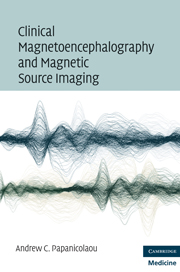Book contents
- Frontmatter
- Contents
- Contributors
- Preface
- Section 1 The method
- Section 2 Spontaneous brain activity
- 11 MEG recordings of spontaneous brain activity – general considerations
- 12 Normal spontaneous MEG – frequently encountered artifacts
- 13 Spontaneous MEG morphology
- 14 Abnormal spontaneous MEG
- 15 Contributions of MEG to the surgical management of epilepsy – general considerations
- 16 MEG investigations in lesional epilepsies
- 17 MEG investigations in nonlesional epilepsies
- 18 Pediatric nonlesional epilepsy surgery
- Section 3 Evoked magnetic fields
- Postscript: Future applications of clinical MEG
- References
- Index
16 - MEG investigations in lesional epilepsies
from Section 2 - Spontaneous brain activity
Published online by Cambridge University Press: 01 March 2010
- Frontmatter
- Contents
- Contributors
- Preface
- Section 1 The method
- Section 2 Spontaneous brain activity
- 11 MEG recordings of spontaneous brain activity – general considerations
- 12 Normal spontaneous MEG – frequently encountered artifacts
- 13 Spontaneous MEG morphology
- 14 Abnormal spontaneous MEG
- 15 Contributions of MEG to the surgical management of epilepsy – general considerations
- 16 MEG investigations in lesional epilepsies
- 17 MEG investigations in nonlesional epilepsies
- 18 Pediatric nonlesional epilepsy surgery
- Section 3 Evoked magnetic fields
- Postscript: Future applications of clinical MEG
- References
- Index
Summary
A major domain of presurgical evaluation is the detection of lesions. About 80% of all surgical epilepsy patients present with a structural lesion on MRI; however, not all of these lesions are causally correlated with epilepsy. Determination of epileptogenicity is, therefore, essential. Functional modalities such as EEG and MEG play a crucial role. Iwasaki and colleagues found that if MEG localizations were congruent with a neocortical temporal lesion then lesionectomy was successful in controlling seizures.
In the case of multiple lesions, one has to decide which subset is relevant for seizure generation and which should consequently be subjected to surgical treatment. Pathologies commonly associated with ictal-onset regions are oligodendro glioma, ganglioglioma, focal cortical malformations, cavernoma with bleeding, or unilateral Ammon's horn sclerosis. More variable associations exist in the case of polymicrogyria, hemimegalencephaly, tuberous sclerosis, Sturge–Weber syndrome, and arachnoidal cysts.
Brain tumors
A considerable number of glioma patients show epileptic activity in the vicinity of tumor boundaries. A close correlation between astrocytoma, ganglioglioma, and leading spike activity within one centimeter of the tumor border was found in temporal lobe epilepsies by Stefan and colleagues. Morioka and his associates showed that the localization of spike dipoles in patients with neurocytoma occurred around the tumor. However, localizations of the hyperexcitable network were not always found in the whole circumference but can show predominant centers of gravity.
Vascular malformations
MEG spike localizations were congruent with spike localizations in intraoperative ECoG in patients with arteriovenous malformations.
- Type
- Chapter
- Information
- Publisher: Cambridge University PressPrint publication year: 2009



